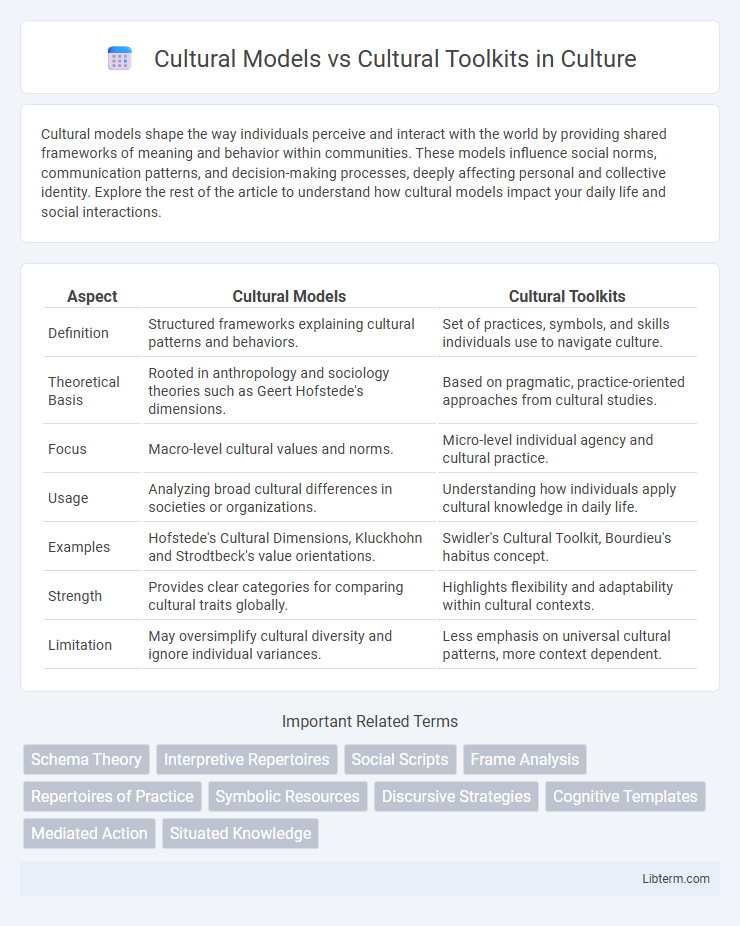Cultural models shape the way individuals perceive and interact with the world by providing shared frameworks of meaning and behavior within communities. These models influence social norms, communication patterns, and decision-making processes, deeply affecting personal and collective identity. Explore the rest of the article to understand how cultural models impact your daily life and social interactions.
Table of Comparison
| Aspect | Cultural Models | Cultural Toolkits |
|---|---|---|
| Definition | Structured frameworks explaining cultural patterns and behaviors. | Set of practices, symbols, and skills individuals use to navigate culture. |
| Theoretical Basis | Rooted in anthropology and sociology theories such as Geert Hofstede's dimensions. | Based on pragmatic, practice-oriented approaches from cultural studies. |
| Focus | Macro-level cultural values and norms. | Micro-level individual agency and cultural practice. |
| Usage | Analyzing broad cultural differences in societies or organizations. | Understanding how individuals apply cultural knowledge in daily life. |
| Examples | Hofstede's Cultural Dimensions, Kluckhohn and Strodtbeck's value orientations. | Swidler's Cultural Toolkit, Bourdieu's habitus concept. |
| Strength | Provides clear categories for comparing cultural traits globally. | Highlights flexibility and adaptability within cultural contexts. |
| Limitation | May oversimplify cultural diversity and ignore individual variances. | Less emphasis on universal cultural patterns, more context dependent. |
Introduction to Cultural Models and Toolkits
Cultural models refer to the shared cognitive frameworks within a society that shape perceptions, behaviors, and social interactions through deeply ingrained beliefs and values. Cultural toolkits encompass the array of strategies, practices, and symbols individuals draw upon to navigate various social situations effectively. Understanding the distinction between cultural models and toolkits is essential for analyzing how collective norms influence individual actions and decision-making processes.
Defining Cultural Models
Cultural models are shared cognitive frameworks that guide individuals' understanding and behavior within a society by providing implicit rules and expectations. These mental structures shape perceptions, decision-making processes, and social interactions, reflecting collectively held beliefs and values. Unlike cultural toolkits, which emphasize flexible repertoires of skills and strategies, cultural models represent stable, deeply ingrained patterns of meaning that influence how people interpret experiences.
Understanding Cultural Toolkits
Cultural toolkits refer to the repertoire of skills, symbols, and narratives that individuals draw upon to navigate social situations, enabling adaptive and context-specific behavior. Unlike cultural models, which represent broad, shared cognitive schemas within a community, toolkits emphasize the strategic and flexible use of cultural resources tailored to personal and social needs. Understanding cultural toolkits highlights the dynamic nature of culture as a set of pragmatic tools employed in everyday decision-making and identity construction.
Core Differences Between Models and Toolkits
Cultural models are structured frameworks representing shared cognitive schemas and norms that guide behavior within a society, while cultural toolkits consist of a diverse set of resources, strategies, and practices individuals draw upon to navigate social situations. Models emphasize collective, stable representations of cultural knowledge, whereas toolkits highlight flexibility and adaptability in applying cultural elements to achieve desired outcomes. The core difference lies in models portraying culture as a consistent mental map, while toolkits view culture as an assemblage of dynamic options for social action.
Origins and Development in Social Theory
Cultural models originate from cognitive anthropology and social psychology, emphasizing shared mental representations that guide individual behavior within societies. Cultural toolkits, developed within sociological frameworks by Ann Swidler, highlight the repertoire of habits, skills, and styles people draw upon to navigate social life, focusing on practice over internalized schemas. The evolution of these concepts reflects a shift from understanding culture as fixed cognitive patterns to dynamic, context-dependent resources shaping social action.
Practical Examples of Cultural Models
Cultural models shape individuals' perceptions and behaviors through shared mental frameworks, such as the American Dream emphasizing self-reliance and success. For instance, in many Asian cultures, the Confucian model prioritizes respect for hierarchy and collective harmony, guiding social interactions and decision-making. These models influence practices like parenting styles, workplace dynamics, and conflict resolution approaches within specific communities.
Real-World Applications of Cultural Toolkits
Cultural toolkits provide flexible repertoires of skills, habits, and symbols that individuals draw on to navigate social situations, unlike rigid cultural models that define fixed norms. Real-world applications of cultural toolkits include adapting communication styles in multicultural workplaces, customizing marketing strategies for diverse consumer segments, and facilitating cross-cultural negotiation by selecting appropriate behavioral scripts. These dynamic resources enable individuals and organizations to respond effectively to cultural variability and complex social environments.
Influence on Identity and Behavior
Cultural models shape identity and behavior by providing internalized frameworks that guide individuals' perceptions and actions according to shared societal norms. Cultural toolkits offer a practical set of skills and symbols that individuals selectively employ to navigate varied social situations, influencing identity expression and behavioral choices dynamically. The interaction between these cognitive structures and adaptable resources determines how cultural meanings are constructed and enacted in everyday life.
Implications for Cross-Cultural Research
Cultural models represent shared cognitive frameworks that guide individuals' perceptions and behaviors within a group, while cultural toolkits consist of flexible repertoires of practices and symbols used to navigate social situations. Understanding these distinctions is crucial for cross-cultural research as it highlights the dynamic nature of culture, emphasizing that individuals actively select cultural resources rather than passively conform to fixed norms. This insight improves the accuracy of cultural analysis by accounting for variability and agency in how people interpret and perform cultural meanings across contexts.
Conclusion: Integrating Models and Toolkits
Integrating cultural models and cultural toolkits offers a comprehensive understanding of human behavior by combining abstract frameworks with practical resources individuals use daily. This synthesis enhances cross-cultural communication and adaptability by recognizing both shared mental schemas and flexible, context-driven actions. Emphasizing the dynamic interplay between models and toolkits enriches anthropological and sociological analyses, fostering more nuanced interpretations of cultural phenomena.
Cultural Models Infographic

 libterm.com
libterm.com